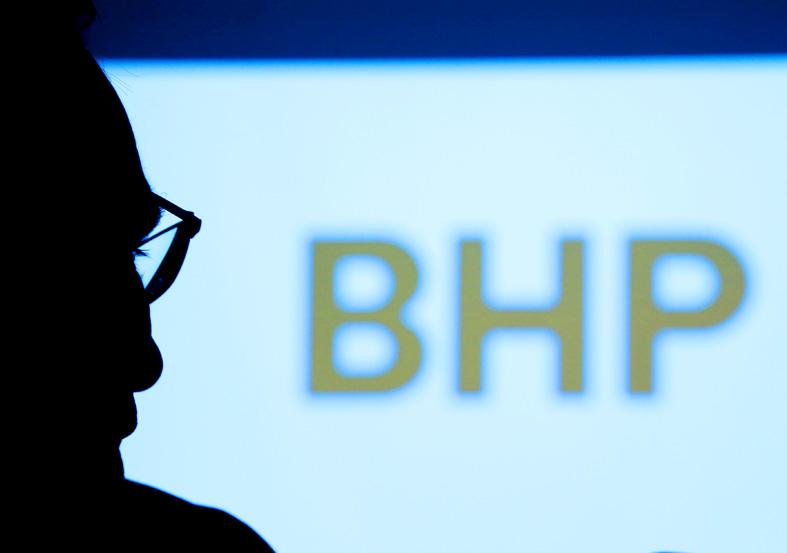BHP Group is to merge its oil and gas operations with Woodside Petroleum Ltd as the biggest miner positions itself for a global shift away from fossil fuels and prepares to plow US$5.7 billion into a massive new fertilizer mine in Canada.
After the deal, BHP shareholders are to own about 48 percent of Woodside, the miner said in a statement yesterday.
The company also said that it would eradicate its dual-listing structure and move to a single primary listing in Australia.

Photo: Reuters
BHP chief executive officer Mike Henry, who took over in January last year, is pivoting toward what the firm calls “future facing” commodities — metals and minerals vital to global efforts to reduce emissions, electrify cities and feed people.
The announcements also help clarify question marks for investors, who have been waiting for years for a decision on Jansen, while the company has said previously its dual listing was up for discussion.
BHP generates the bulk of its profits from iron ore and copper — a metal that is central to a green-energy transition — and benefited from soaring prices for both commodities over the past year.
The company reported record free-cash flow for the year through June and said that it would pay a final dividend of US$10.1 billion.
Underlying profit rose 88 percent to US$17.08 billion for the year.
The commodities giant is getting out of oil and gas as the fossil-fuel industry grapples with global pressure from investors and governments over climate action, prompting some larger oil rivals to shrink their core production and add renewable energy assets.
While BHP has said it expects demand to remain strong for at least another decade, the company wants to avoid getting stuck with assets that are expected to become more difficult to sell.
BHP has also finally approved the first stage of construction of the Jansen potash mine in Saskatchewan, Canada, after years of wavering over the huge price tag.
The operation, expected to start production in 2027, is to make it one of the world’s top producers of the crop nutrient.
“Potash provides BHP with increased leverage to key global mega-trends, including rising population, changing diets, decarbonization and improving environmental stewardship,” the company said.
It is also the latest sign that the biggest miners are ready to open their wallets to invest in new mines after years of austerity.
The industry has been focused on shareholder returns and debt reduction after being penalized by investors for overspending.
Smaller rival Rio Tinto Group last month announced that it plans to spend US$2.4 billion building a lithium mine in Serbia as it also seeks to expand in battery metals.
BHP has already spent about US$4.5 billion on Jansen and dug two 1,000m shafts, but held off on a final development decision as it weighed the risks of the large investment.
Potash prices have jumped this year amid strong demand, as well as worries about supply after Belarus, one of a handful of producing nations, was hit by sanctions.
The Jansen approval follows BHP’s announcement last month that it agreed to buy a nickel mine developer in Canada.
It is also expanding existing nickel operations in Australia and building a stake in a copper company in Ecuador.

HANDOVER POLICY: Approving the probe means that the new US administration of Donald Trump is likely to have the option to impose trade restrictions on China US President Joe Biden’s administration is set to initiate a trade investigation into Chinese semiconductors in the coming days as part of a push to reduce reliance on a technology that US officials believe poses national security risks. The probe could result in tariffs or other measures to restrict imports on older-model semiconductors and the products containing them, including medical devices, vehicles, smartphones and weaponry, people familiar with the matter said. The investigation examining so-called foundational chips could take months to conclude, meaning that any reaction to the findings would be left to the discretion of US president-elect Donald Trump’s incoming team. Biden

Intel Corp chief financial officer Dave Zinsner said that a formal separation of the company’s factory and product development divisions is an open question that would be decided by the chipmaker’s next leader. Zinsner, who is serving as interim co-CEO following this month’s ouster of Pat Gelsinger, made the remarks on Thursday at the Barclays technology conference in San Francisco alongside co-CEO Michelle Johnston Holthaus. Intel’s struggles to keep pace with rivals — along with its deteriorating financial condition — have spurred speculation that the next CEO would make dramatic changes. That has included talk of a split of the company’s manufacturing

HOUSING: The uptick to 2.24 percent came despite the central bank leaving its policy unchanged for two quarters and raising lenders’ required reserve ratios Mortgage interest rates last quarter spiked to a 15-year high of 2.23 percent despite a decline in loan applications, as local lenders slowed real-estate lending to support the central bank’s credit controls, Taiwan Realty Co (台灣房屋) said yesterday. “The data suggests that buying a home is growing increasingly difficult,” the brokers said, citing data from the Joint Credit Information Center (聯徵中心). The uptick in mortgage burdens came even though the central bank left its policy rates unchanged in the past two quarters and hiked the lenders’ required reserve ratios to drain money from the market, head researcher Charlene Chang (張旭嵐) said. Further, the

In a patch of South America rich in lithium, used to make batteries for electric cars and other tech, Bolivia is lagging its neighbors in the race to mine the key metal. An area called the “lithium triangle” which spills over the borders of Bolivia, Chile and Argentina is home to 60 percent of the world’s lithium reserves, according to the US Geological Survey. Bolivia claims to have Earth’s largest deposit of the metal, used to make rechargeable batteries for smartphones, laptops and other devices besides e-vehicles. However, Bolivia has undertaken only four pilot projects and is running just one